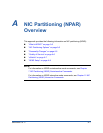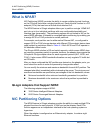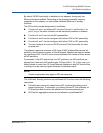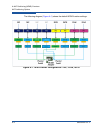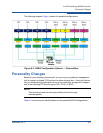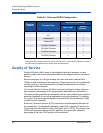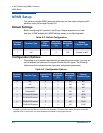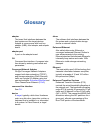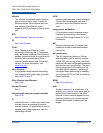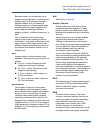
SN0054667-00 C Glossary-3
User’s Guide QConvergeConsole CLI
2400, 2500, 3200, 8100, 8200 Series
Because a path is a combination of an
adapter and a target port, it is distinct from
another path if it is accessed through a
different adapter or it is accessing a
different target port. Consequently, when
switching from one path to another, the
driver might be selecting a different
adapter (initiator), a different target port, or
both.
This is important to the driver when
selecting the proper method of failover
notification. It can make a difference to the
target device, which might have to take
different actions when receiving retries of
the request from another initiator or on a
different port.
port
Access points in a device where a link
attaches. There are four types of ports, as
follows:
N_Port—a Fibre Channel port that
supports point-to-point topology.
NL_Port—a Fibre Channel port that
supports loop topology.
F_Port—a port in a fabric where an
N_Port can attach.
FL_Port—a port in a fabric where an
NL_Port can attach.
port instance
The number of the port in the system.
Each adapter may have one or multiple
ports, identified with regard to the adapter
as port 0, port 1 and so forth. To avoid
confusion when dealing with a system
containing numerous ports, each port is
assigned a port instance number when the
system boots up. So Port 0 on an adapter
might have a port instance number of 8, for
example, if it is the eighth port discovered
by the system.
QoS
See Quality of Service.
Quality of Service
Quality of Service (QoS) refers to the
bandwidth allocation assigned to each
partition used to send and receive data
between the adapter port and connected
devices.
Each physical port on a QLogic adapter
can send and receive data at up to
10Gbps in both directions at the same
time. When the physical port is partitioned
into four partitions, the port bandwidth is
divided between each port partition
according to traffic demands.
You can set Quality of Service (QoS) for
each port partition by setting minimum and
maximum percentages of the physical
port's bandwidth for each partition. This
feature helps guarantee a transmission
rate for each partition that requires a
particular bandwidth to run critical applica-
tions using port partitions. The setting for a
given QoS can resolve bottlenecks that
exist when Virtual Machines (VMs)
contend for port bandwidth.
RAID
Redundant array of independent/inexpen-
sive disks. RAID are fault-tolerant disks
that look like either single or multiple
volumes to the server.
RAM
Random-access memory. The most
common computer memory that can be
used by programs to perform necessary
tasks while the computer is on; an
integrated circuit memory chip. RAM
allows information to be stored or
accessed in any order (randomly), and all
storage locations are equally accessible.



